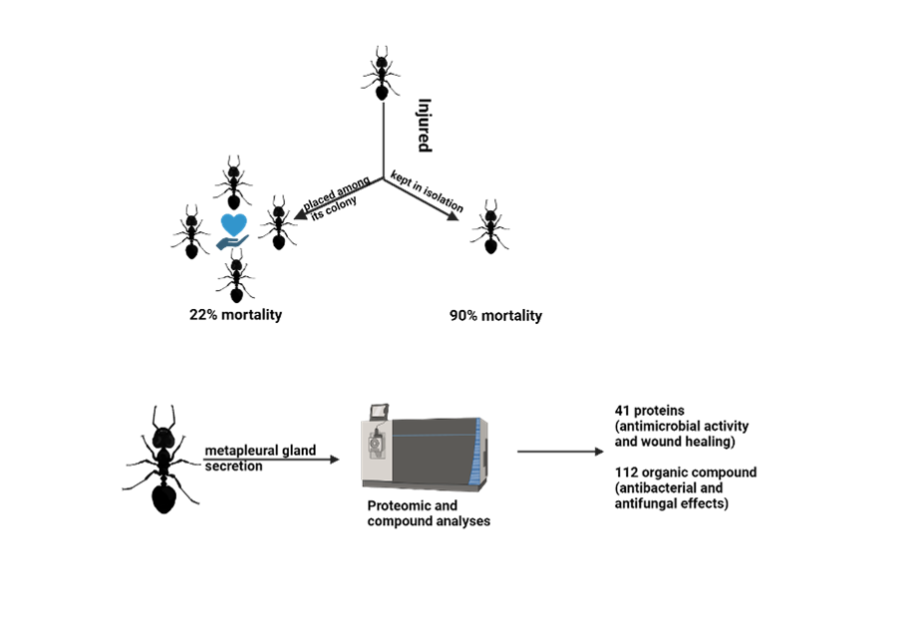
Since the dawn of our existence, animals have engaged in a millennia-long battle with bacterial pathogens, with contagious diseases posing some of the greatest threats to their existence. In outbreaks and pandemics, humans often display remarkable bravery by providing care to the infected ones rather than avoiding them. Caregiving is one of the most primitive and effective strategies for disease control in human populations1. However, we should not be too proud of ourselves, as we are not the only species that cares for the sick2. Studies have shown that evolutionary forms of care for the sick also exist in distantly related species, such as insects, suggesting that the evolutionary building blocks of caregiving are older than the human lineage.
The workers of the predatory raiding ants, Megaponera analis, have developed an effective method to combat infections by caring for injured nestmates. These ferocious ants, which tactically feed exclusively on pugnacious termites, display complex and well-organised behaviour during raids. However, even the best strategies have their own flaws. Nearly 22% of the raiders lose one or two legs during attacks on termites3. These fallen warriors are carried back to the nest for treatment by other workers. Means of treatment include wound licking and wound grooming. These injuries are severe and can be fatal, with up to 90% of untreated ants dying within 24 hours. The mechanism behind this remarkable wound care has long puzzled scientists.
In a recent study published in Nature Communications by Erik T. Frank and colleague4s, researchers uncovered the antimicrobial properties of how nursing workers treat ants injured during raids. First, the scientists wanted to confirm whether injured workers die from infections. To answer this, the scientists mimicked injuries in ants and applied either soil samples collected from the natural environment (test group) or sterile phosphate-buffered saline (PBS) (control group). After 11 hours, the bacterial load in the injured thoraxes treated with soil was 100 times higher than in those treated with PBS. To test whether bacterial load was the cause of death, both test and control ants were placed either in colonies or in isolation. Mortality among test groups in colonies was significantly lower (22%) compared to those in isolation (90%).
Microbiome analysis revealed three major pathogens in the injured ants: Klebsiella, Pseudomonas, and Burkholderia species. While Burkholderia did not significantly impact survival, Pseudomonas aeruginosa caused 93% mortality within 36 hours. To investigate the mechanism by which the ants treat wound infections, the researchers placed injured ants (both sterile and infected) in colonies and filmed them for 24 hours. Workers caring for the injured ants were observed applying secretions from their metapleural gland (MG), a gland located in back of the thorax. MG secretions showed a 25% reduction in the growth of P. aeruginosa in broth compared to the control broth. The MG secretions analyses revealed 41 proteins, some of which have antimicrobial properties such as toxins and enzymes that break down bacterial cell walls, as well as proteins that promote wound healing. Additionally, compound analysis of MG secretions revealed 112 organic compounds, six of which have antibiotic and antifungal-like structures, along with carboxylic acids that may help lower the pH in wounds, leading to bacterial death.
This impressive study demonstrates how a species of ants has evolved to employ therapeutic practices for their injured nestmates. Humans and ants share similar strategies against common threats. Antimicrobial resistance was responsible for an estimated 1.27 million deaths in 2019. Interestingly, the same bacterium that threatens the lives of Megaponera analis ants—Pseudomonas aeruginosa—is also a major concern for humans as a member of the notorious multidrug-resistant ESKAPE pathogens (where P stands for Pseudomonas). Humans can learn a great deal from these ants, not only by understanding their complex care systems but also by developing novel antibiotics based on the compounds found in the MG secretions of these remarkable creatures.
1. Hart, B. L. Behavioural defences in animals against pathogens and parasites: Parallels with the pillars of medicine in humans. Philosophical Transactions of the Royal Society B: Biological Sciences 366, (2011).
2. Kessler, S. E. Why Care: Complex Evolutionary History of Human Healthcare Networks. Frontiers in Psychologyvol. 11 Preprint at https://doi.org/10.3389/fpsyg.2020.00199 (2020).
3. Frank, E. T. et al. Saving the injured: Rescue behavior in the termite-hunting ant Megaponera analis. Sci Adv 3, (2017).
4. Frank, E. T. et al. Targeted treatment of injured nestmates with antimicrobial compounds in an ant society. Nat Commun 14, (2023).
LSHTM's short courses provide opportunities to study specialised topics across a broad range of public and global health fields. From AMR to vaccines, travel medicine to clinical trials, and modelling to malaria, refresh your skills and join one of our short courses today.
